Russell Sage Foundation
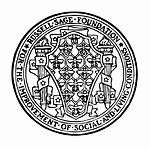 | |
| Founded | 1907 |
|---|---|
| Founder | Margaret Olivia Slocum Sage |
| Type | Private Foundation |
| Location |
|
Key people | President - Sheldon Danziger |
| Endowment | $275 million (2015) |
| Mission | The improvement of social and living conditions in the United States |
| Website |
www |
The Russell Sage Foundation is an American philanthropic foundation that primarily funds research relating to income inequality.[1] Located in New York City, it is a research center and a funding source for studies by scholars at other academic and research institutions. The foundation also publishes, under its own imprint, the books that derive from the work of its grantees and visiting scholars. The foundation focuses on labor markets, immigration and ethnicity, and social inequality in the United States, as well as behavioral economics.
History
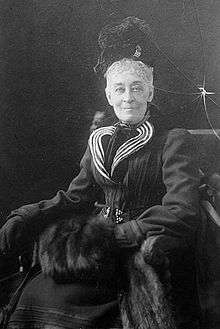
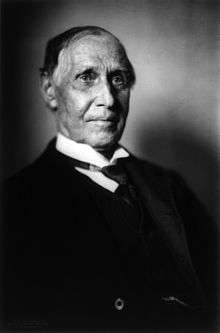
The Russell Sage Foundation was established in 1907 for "the improvement of social and living conditions in the United States" by a gift of $10 million from Margaret Olivia Slocum Sage (1828–1918), widow of railroad magnate and financier Russell Sage.[2] Mrs. Sage directed the foundation to pursue its mission through a broad set of activities, including "research, publication, education, the establishment and maintenance of charitable or benevolent activities, agencies and institutions, and the aid of any such activities, agencies, or institutions already in existence."[3] Her will added a $5 million bequest in 1917.[4]
Early years
Soon after its establishment, the Foundation played a pioneering role in dealing with problems of the poor and the elderly, in efforts to improve hospital and prison conditions, and in the development of social work as a profession. The Foundation was also responsible for early reforms in health care, city planning, consumer credit, labor law, the training of nurses, and social security programs.[5]
In 1907, the foundation funded the Pittsburgh Survey,[6] the first systematic effort to survey working class conditions in a large U.S. city. Considered a major Progressive Era achievement, the findings inspired labor reforms and helped end twelve-hour days and seven-day weeks for steel workers.[7]
Between 1909 and 1922, the Foundation spent nearly a sixth of its capital to build Forest Hills Gardens, a model suburban community for working families designed by architect Frederick Law Olmsted. The aim was to demonstrate the economic and social viability of an intelligently planned suburban community.[8] The first lots sold for $800, and a new suburb began thriving by 1917, but housing prices soon soared beyond the range of the families they were intended for.[5]
In 1922, the Foundation helped launch the Regional Plan Association to research, write and publish a plan to guide the future development of the New York metropolitan region. In its first 40 years, the Foundation spent more than $1 million on the Regional Survey and Plan. Researchers completed 12 massive volumes as part of the effort, with the first being published in 1928-29.[9] The RPA was not opposed to the growth of the area and its population, but believed that for the development to be efficient and orderly, it had to be properly managed; only in this way could businesses continue to grow and the city maintain its global impact.[10]
The Foundation also provided support for social feminists such as Mary van Kleeck, founder of the International Institute of Industrial Relations.[11]
1945 - 1980
Since World War II, the Foundation has devoted its efforts to strengthening the social sciences as a means of achieving more informed and rational social policy. It launched a variety of programs to draw the social sciences closer to decision-makers in other professions, from policymakers to health care providers. This initiative included funds for research on "social indicators", a collection of data that measure the quality of life.[12]
In the 1950s, the Foundation supported research on the practice and aims of philanthropy. It established the Foundation Center, a non-profit that maintains data on organized philanthropy. It was also the first to publish The Foundation Directory, a comprehensive listing of the nation’s several thousand largest foundations.[13] During this decade, the foundation also received money from the Ford Foundation ($554,000) for the "practical utilization of the behavioral sciences".[14]
In the 1960s and 1970s, the Foundation turned to medical ethics, including patients' rights, extreme measures to sustain life, and the use of human subjects in research. Foundation-supported books from this period include Bernard Barber’s Drugs and Society (1967) and The Dying Patient (1970).[15]
1980s - present
The Foundation was an early force in the development of behavioral economics,[16] launching the Behavioral Economics program in 1986 with the Alfred P. Sloan Foundation.[17] Books on behavioral economics published by Russell Sage include Quasi Rational Economics (1991)[18] and Advances in Behavioral Finance (1993).[19]
In 1993, the Foundation also established the Behavioral Economics Roundtable,[17] a group of behavioral economists elected by grantees in the program and charged to design initiatives to advance the field. Three charter members of the Roundtable subsequently received the Noble Prize in economics: George Akerlof, Daniel Kahneman, and Thomas Schelling.
The Foundation launched new programs to study immigration, the rise of economic inequality and contact among cultures within the American population. Between 1992 and 2000, the Foundation worked with the Ford Foundation to conduct a Multi-City Study of Urban Inequality.[20] In 2000, the Foundation partnered with the Population Reference Bureau (PRB) to produce The American People: Census 2000, edited by Reynolds Farley of the University of Michigan and John Haaga of PRB.[21]
In 2015 the Foundation partnered with the Robert Wood Johnson Foundation on an initiative exploring the social, economic and political effects of the Affordable Care Act.[22] The Foundation also launched RSF: The Russell Sage Foundation Journal of the Social Sciences, a peer-reviewed, open-access journal of social science research.[23]
Current activities
Research
The Foundation currently pursues four principal programs:
- A program of research on the Future of Work concerned principally with the causes and consequences of changes in the quality of low-wage work in the United States and other advanced economies.[24]
- A program of research on Race, Ethnicity, and Immigration concerned with the social, economic, and political effects of the changing racial and ethnic composition of the U.S. population, including the transformation of communities and ideas about what it means to be American. This program was formed to replace two prior programs, Immigration and Cultural Contact, in 2015.[25]
- A program on Social Inequality, focused on the social effects of rising economic inequality, with particular attention to the ways in which the U.S. political and educational systems have responded to growing economic disparities.[26]
- A program of research on Behavioral Economics which incorporates the insights of psychology and other social sciences into the study of economic behavior.[17]
The principal programs feature a number of working groups:
- The Biology and Social Science Working Group examines how the incorporation of biological concepts, processes and measures in social science research might improve our understanding of a range of social and economic outcomes.[27]
- The Racial Bias in Policing Working Group examines the impact of racial, ethnic, and gender-based attitudes on law enforcement. The group is working with metropolitan police departments across the U.S. to develop policies to reduce racial bias in law enforcement.[28]
- The Cultural Contact and Immigration Working Group examines immigrant life outside of customary gateway cities such as New York, Miami, or Los Angeles, with an emphasis on the cultural frictions resulting from the rapid growth of the foreign-born population in the United States at a time of high economic uncertainty and political polarization.[29]
In addition to the activities sponsored under its main programs, the Foundation also currently supports a special initiative on the social, economic and political effects of the Affordable Care Act.[30]
Books
The Foundation publishes books on a variety of subjects, with particular emphasis on work related to its programs. Notable recent publications include Punishment and Inequality in America by Bruce Western, winner of the 2007 Albert J. Reiss, Jr. Distinguished Scholarship Award and the 2008 Michael J. Hindelang Book Award from the American Society of Criminology;[31] The Long Shadow: Family Background, Disadvantaged Urban Youth, and the Transition to Adulthood, for which authors Karl Alexander, Doris Entwisle, and Linda Olson won the 2016 Grawemeyer Award in Education;[32] The American Non-Dilemma by Nancy DiTomaso, winner of the 2013 C. Wright Mills Award;[33] and Unequal Time: Gender, Class, and Family in Employment Schedules by Dan Clawson and Naomi Gerstel, winner of three awards from the American Sociological Association.[34]
The Foundation is also the publisher of the American Sociological Association’s distinguished Rose Series in Sociology.
Visiting Scholars and Journalists programs
The Russell Sage Foundation has established a center where Visiting Scholars can pursue their writing and research.[35] Each year, the Foundation invites a number of scholars to its New York City headquarters to investigate topics in social and behavioral sciences. The Foundation particularly welcomes groups of scholars who wish to collaborate on a specific project during their residence at Russell Sage. Typically Visiting Scholars work on projects related to the Foundation’s current programs.
In 2015 the Foundation established a Visiting Journalists program to support journalists undertaking original research on social, political, and economic conditions in the United States. The spring 2016 Visiting Journalists are Carole A. Carmichael, formerly of the Seattle Times, and Eyal Press, author of Beautiful Souls: Saying No, Breaking Ranks, and Heeding the Voice of Conscience in Dark Times (2012).[36]
Robert K. Merton Scholar
- In 1990, Robert K. Merton became the first Foundation Scholar at Russell Sage, recognizing his long and invaluable service as an adviser to the administration and a mentor to other visiting scholars.
- In 2000, Nobelist Robert M. Solow became the second Foundation Scholar, following Merton’s retirement. In 2003, the position was renamed the Merton Scholar.
Archives
The Foundation's archives are located in the Rockefeller Archive Center in Sleepy Hollow, New York.[37]
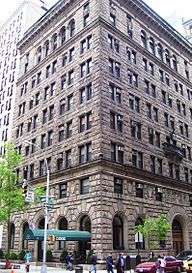
Headquarters buildings
When the Foundation was formed, it attempted to locate its offices in the United Charities Building on Park Avenue South and East 22nd Street in Manhattan, but was unable to do so as the building was fully rented; instead, the new foundation spread out to a number of locations in the area. In 1912, Margaret Sage and Robert de Forest decided to construct a headquarters building for the Foundation which would also serve as a memorial to her late husband. They engaged Beaux-Arts architect Grosvenor Atterbury, who had designed the Forest Hills Gardens model housing project for the Foundation in 1908, to design the building, and purchased property at 120 East 22nd Street at the corner of Lexington Avenue, just down the street from both United Charities Building and the Church Missions House of the Episcopal Church, and a short block from Gramercy Park. The building, which was originally nine stories before a penthouse was added in the 1920s, was constructed between 1912 and 1913 and altered in 1922-1923. A fifteen-story extension on East 22nd, which Atterbury also designed, connected to the original building with a five-story "hyphen", was added between 1930 and 1931.[38][39]
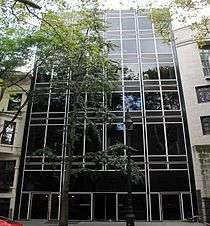
Atterbury's design took the form of a Renaissance Florentine palazzo. Because it was both headquarters for the Foundation and a physical memorial for Sage, the building was more opulently constructed than would generally be the case for a charity. Atterbury utilized expensive materials in the interior, such as rare Kingwood sandstone in the elevators.[38] The 1922-1923 alteration added second floor sculptural panels by Rene Paul Chambellan illustrating the foundation's ideals, goals and deeds.[40]
The Foundation made available space in the main building, at no charge, to other social-service organizations, such as the Family Welfare Association of America, the American Association of Social Workers and the Library of Social Work, which took up the top two floors of the main building. Space in the 22nd Street extension was rented out, and the New York School of Social Work was the primary tenant.[38]
The Foundation sold the building in 1949 to the Archdiocese of New York which used it as the headquarters of Catholic Charities, and it was sold again in 1975, after which it was converted to apartments; it is now called Sage House.[38] The building was designated a New York City landmark in 2000,[40] and is part of a proposed extension to the Gramercy Park Historic District.[41]
Since 1981, the Foundation has been headquartered in a Philip Johnson-designed International Style building at 112 East 64th Street between Park and Lexington Avenues, built in 1958-1960 for the Asia Society and Japan Society. The building is located in the Upper East Side Historic District.[42][43]
References
Notes
- ↑ Callahan, David (April 14, 2015). "Inside the Russell Sage Foundation's Epic Dig Into Why Inequality Matters". Inside Philanthropy. Retrieved 15 June 2016.
- ↑ "Margaret Olivia Sage, Founder of the Russell Sage Foundation", Auburn University Digital Libraries
- ↑ Letter of Gift, April 19, 1907
- ↑ Glenn et al. (1947), p.xvii
- 1 2 "Celebrating 100 Years of Social Science Research", 2007
- ↑ "The Pittsburgh Survey," by Paul Kellogg in "Charities and the Commons" 1909
- ↑ Overland, Martha Ann (13 January 2011), "To Fight Poverty, A Fund Changes Tactics But Sticks To Its Mission", The Chronicle of Philanthropy
- ↑ Glenn et al. (1947), p.49
- ↑ Keele, Harold, ed. (1984). Foundations. Joseph C. Kiger (1984 ed.). Westport, Conn.: Greenwood Press. p. 376.
- ↑ Steinberg, Ted (2010), Gotham Unbound: The Ecological History of Greater New York, New York: Simon & Schuster, pp. 187–88, ISBN 978-1-476-74124-6
- ↑ Alvon, Guy (1992). Nelson, Daniel, ed. A Mental Revolution: Scientific Management since Taylor (PDF). Columbus Ohio: Ohio State University Press.
- ↑ "Social indicators" on the Russell Sage Foundation website
- ↑ Foundation Center
- ↑ The Ford Foundation Annual Report. The Ford Foundation. 1957. p. 78.
- ↑ "The Dying Patient | Russell Sage Foundation". www.russellsage.org. Retrieved 2016-03-11.
- ↑ Heukelom, Floris (2011), "A Sense of Mission: The Alfred P. Sloan and Russell Sage Foundations' Behavioral Economics Program, 1984-1992", Forthcoming, Science in Context
- 1 2 3 "Behavioral Economics" on the Russell Sage Foundation website]
- ↑ "Quasi Rational Economics" on the Russell Sage Foundation website
- ↑ "Advances in Behavioral Finance" on the Russell Sage Foundation website
- ↑ "Multi-City Study of Urban Inequality" on the Russell Sage website
- ↑ "The American People: Census 2000" on the Russell Sage Foundation website
- ↑ "Co-Funded Research | Russell Sage Foundation". www.russellsage.org. Retrieved 2016-03-11.
- ↑ "RSF Journal". www.rsfjournal.org. Retrieved 2016-03-11.
- ↑ "Future of Work" on the Russell Sage Foundation website
- ↑ "Race, Ethnicity, and Immigration" on the Russell Sage Foundation website
- ↑ "Social Inequality" on the Russell Sage Foundation website
- ↑ "Biology and Social Science Working Group" on the Russell Sage Foundation website
- ↑ "Racial Bias in Policing Working Group" on the Russell Sage Foundation website
- ↑ "Cultural Contact and Immigration Working Group" on the Russell Sage Foundation website
- ↑ "The Social, Economics, and Political Effects of the Affordable Care Act" on the Russell Sage Foundation website
- ↑ "Punishment and Inequality in America | Russell Sage Foundation". www.russellsage.org. Retrieved 2016-03-11.
- ↑ "Grawemeyer Awards | Alexander, Entwisle and Olson win education award for "The Long Shadow"". grawemeyer.org. Retrieved 2016-03-11.
- ↑ "Professor Nancy DiTomaso's "The American Non-Dilemma" wins C. Wright Mills Award | Rutgers Business School". www.business.rutgers.edu. Retrieved 2016-03-11.
- ↑ "Unequal Time | Russell Sage Foundation". www.russellsage.org. Retrieved 2016-03-11.
- ↑ "Visiting Scholars" on the Russell Sage Foundation website
- ↑ Staff. (November 16, 2015) "RSF Announces Spring 2016 Visiting Journalists" Russell Sage Foundation website
- ↑ Rockefeller Archive Center website
- 1 2 3 4 "Russell Sage Foundation" on Gramercy Neighborhood Associates
- ↑ The 5-story connector building was necessitated by a covenant to the deed for the site, which was sold to the Foundation by the Gramercy Park Hotel. The intention was to preserve access to sunlight for the hotel's north-facing rooms.
- 1 2 New York City Landmarks Preservation Commission; Dolkart, Andrew S. (text); Postal, Matthew A. (text) (2009), Postal, Matthew A., ed., Guide to New York City Landmarks (4th ed.), New York: John Wiley & Sons, ISBN 978-0-470-28963-1, p.86
- ↑ "Proposed Extension to the Gramercy Park Historic District" on Gramercy Neighborhood Associates
- ↑ New York City Landmarks Preservation Commission; Dolkart, Andrew S. (text); Postal, Matthew A. (text) (2009), Postal, Matthew A., ed., Guide to New York City Landmarks (4th ed.), New York: John Wiley & Sons, ISBN 978-0-470-28963-1, p.155
- ↑ White, Norval & Willensky, Elliot (2000), AIA Guide to New York City (4th ed.), New York: Three Rivers Press, ISBN 978-0-8129-3107-5, p.391
Bibliography
- Crocker, Ruth (2006). Mrs. Russell Sage: Women's Activism and Philanthropy in Gilded Age and Progressive Era America. Indiana University Press.
- Glenn, John M.; Brandt, Lilian; Andrews, F. Emerson (1947). Russell Sage Foundation, 1907-1946. Russell Sage Foundation.
- Heukelom, Floris (2015). Behavioral Economics: A History. Cambridge University Press.
External links
| Wikimedia Commons has media related to Russell Sage. |
| Wikimedia Commons has media related to Russell Sage Foundation Building (Sage House). |
- Official website
- Investigation of Poverty, Russell Sage Foundation, 1933 painting by Alice Neel
- Russell Sage Foundation Archives